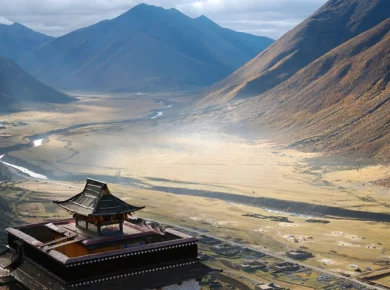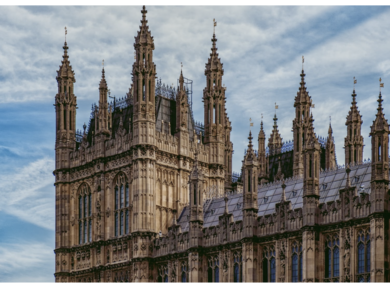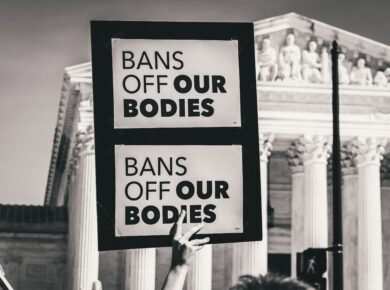Disclaimer: This blog post solely reflects the opinion of the authors and should not be taken to represent the general views of IPPR’s management/ editorial team or those of fellow authors.
The horror of Fukushima, 10 years on, has come back to haunt us. On 13th April 2021, Japan had officially approved its plan to discharge more than a million tonnes of treated radioactive water from the ruined Fukushima Daichi nuclear power plant into the Pacific Ocean. In 2011, the atrocious combo of tsunami and earthquake severely damaged the power plant, including its cooling system. Since then, the site has accumulated over a million tonnes of radioactive water, including water used to cool down the reactors and contaminated underground water.
Storage tanks for radioactive water are lined up at the tsunami-crippled Fukushima No. 1 nuclear power plant in Fukushima Prefecture in February. | KYODO
As of early 2021, around 1.3 million tonnes of radioactive water has been stored on-site in over 1,000 tanks, sizing up to the equivalent of water for 500 Olympic-sized swimming pools. As storage rooms will soon run out, the Japanese government and the plant’s operator, Tokyo Electric Power (TEPCO), believes discharging them is the “most realistic” option.
The Japanese plan to complete the gradual discharge over decades’ of time and are expecting to begin the releasing process in the next few years. The process begins by treating the radioactive water through the ALPS (Advanced Liquid Processing System), in order to meet the international safety guidelines for nuclear plant wastewater. And then diluting the remaining radioactive isotopes to meet WHO’s standards for drinking water.
Whilst the plan sounds like a desperate, yet thorough plan, it was met with a huge backlash, both internationally and domestically.
Should we be concerned?
The best way to understand the problem is to ask three questions. Is it safe? Can we trust the operators? And ultimately, are they held accountable? Is it safe?
The answer from Japan was “Yes”, it is safe. The Japanese government has cited backing from the Director-General of the International Atomic Energy Agency that there is nothing new about nuclear waste discharge. And after treatment from the ALPS and diluting, the water will be safe for release.
Upon second glance, this plan seems very much like one of those “why do humans never learn” policy that you would see in the first 10 minutes of a doomsday movie. In fact, many including the UN and Greenpeace have proposed formal concerns. UN’s independent experts’ concerns that Japan’s treatments may not be as effective as they wish. That the ALPS had failed to clean water below regulatory levels at Fukushima and remaining isotopes would have a longer risk than expected for over 100 years. They also have the potential of moving up the food chain, potentially affecting humans. Greenpeace even further accused the Japanese government of downplaying the risk of carbon-14, a radioactive substance that has the potential to damage human DNA.
So, is it safe? Perhaps the condition of these tanks of water is the safest the TEPCO can achieve given the current technologies. But it is far from safe for the standards we hold for our ecosystem. For an issue with such significant potential of environmental catastrophe, we must leave no room for anything like that.
Can we trust the operators? –
Unlike most Japanese companies who enjoy the fame of providing and well-mannered services, the monopolistic TEPCO is one with a bit more of a suspicious history. Naomi Hirose, the company’s president in 2016, apologized over his previous leadership’s handling of the 2011 disaster, commenting that it was “extremely regrettable”.
The officials of TEPCO in 2011, despite being fully aware of a reactor meltdown, intentionally mischaracterized the incident as a “core damage” for two months. The delay in disclosure caused greater radiation leaks forcing residents around the area to permanently leave their homeland. In the same year, Shukan Bushan (a local media outlet) exposed the company’s further misconduct in labour employment in the ruined power plant, which the company subsequently admitted. The misconduct includes not providing radiation checks for 69 workers, 30 of which did not even have their names recorded. It was also discovered that many of the workers hired after the incident were from a known Japanese mafia front company.
Of course, background discrimination should not be encouraged. Yet, for gangs that are notorious for coercing and exploiting people, it is rather worrying whether these workers will have the dedication and professionalism to conduct such crucial jobs. In addition to the company’s record of not looking after these workers, TEPCO’s dedication is put in doubt. The company seems to be more interested in cover-up and mover over properly taking care of this nuclear catastrophe.
With that being said, we should not punish the company for their wrongs years ago because we cannot simply assume history will repeat itself. Or can we? Unfortunately, the company has a long history of cover-ups even before the 2011 disaster. In a 2007 investigation, the company admitted around 200 occasions of submission of false data to the authorities, dating back to 1986. And in 2000, Kei Sugaoka, an engineer working for TEPCO’s partner GE, blew the whistle saying that the company pressured him to omit the damages he discovered during inspections. What has been repeating itself is not only TEPCO’s misconduct but also their apologies, which seems to have never truly meant anything.
So, the answer to the question is perhaps “No”. A company that has shown greater interest in avoiding responsibilities and refuses to learn from mistakes is not trustworthy enough to discharge nuclear waste into the sea.
Are they held accountable? –
Another way to understand this question is, can they be scrutinised? Since the announcement of the plan, many parties have questioned the decision, yet as of May 2021, there was little effective scrutiny. The parties that expressed concerns include neighbouring authorities like China, Korea and Taiwan, international organisations like the UN and Greenpeace and domestic environmentalists and fishing communities. Pointing a wide variety of issues ranging from regional ecosystem damage to the economic perspectives of local businesses.
Unfortunately, none of the above has shaken Japan’s faith in this plan.
Realistically, neither of these parties has an effective authority above the Japanese government to hold them accountable. And the most practical effect is to pressure them but to a very light scale.
What does this mean?
First and foremost, the purpose of this article is not to kickstart any blame game, but to gain an overview of the obstacles and potential solutions for Fukushima. The moment when these water tanks become a burden, we are presented with two options. Either to get rid of them or take good care of them. The easier way out is to get rid of them with the most cost-efficient plan and minimum hassle. On the other hand, taking up more responsibility would require the operator to bear some degree of loss for a foreseeable future. Discharging radioactive water could become a responsible plan if only its hazards are minimised to an environmentally friendly level, or else it would become a desperate quick way out.
It must be made clear to the international society that this is an international crisis that requires international efforts. Whilst the international community may have nothing to do with the causes of it, we are all subject to the same threat. And we all need to take our part in ensuring a responsible sustainable plan.
In a realist view, there is no way for us to direct the Japanese government and TEPCO’s decisions because even the UN realistically has no authority over them. But we can mobilise public opinion and support to pressure them. Recent years have witnessed many successful social movements. By putting the economy and votes at the stake, we can manifest effective leverage over an irresponsible release. The media could contribute significantly by raising concerns and educating the public. At the status quo, the lack of mainstream media attention has been disappointing.
With that being said, we should give credit to TEPCO and the Japanese government for maintaining the site during the past decade. It is very hard to come to a moral judgement as to whether they are responsible for this (given the risk is assumed to exist at the construction of the power plant), but to some extent, they have prevented a greater catastrophe for the international society. And ideally, the international society should reach out with a helping hand. Because no matter how much pressure we can mobilise, we cannot prevent an irresponsible discharge if the Japanese are left with no more alternative capacities.
Some have speculated that there are plenty of vacant lands for further storage of radioactive water, and TEPCO has omitted them so that they have an excuse of releasing them into the sea. While there is no way to verify this at the status quo, this speculation has pointed out the most realistic job we can do. That is to make sure that discharging radioactive water into the sea will always remain the last resort.
Bibliography:
McCurry, J., 2021. Fukushima: Japan announces it will dump contaminated water into sea. [online] the Guardian. Available at: .
BBC News. 2021. Fukushima: Japan approves releasing wastewater into ocean. [online] Available at:







